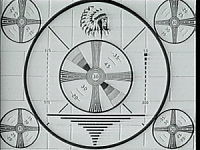

| All the station managers I know are really tight with a buck. When television was young, the one thing they wanted to avoid was paying for programming. The networks paid the stations to carry their programs with the commercials in them, and the stations made extra revenue by selling commercials on th breaks between shows and a few spots were available within. | |
Nobody can carry network programming for the whole broadcast day, so the station manager has to fill those holes some way. Today they are forced to pay for expensive shows, ones that have made high ratings during their first run. But in the early days it was still new to the station managers or program directors, and they hated to buy something costly like those "Million Dollar Movie" packages. Besides everything was on film, there was no tape. |
 Indian Head Test Pattern |
|
The solution was to run public service films in the holes in your programming day. Of course, the Army and the Navy and the Red Cross and other big organizations loved it. They made recruiting films and documentaries plugging their cause by the dozens. Then they sent out copies to all the TV stations. You received a film and after you had run it, you were told where to send it on to the next station. This process was called "bicycling." At KLTV, a station in Tyler, Texas, the manager was especially closed-fisted. I was their first full time director. We not only directed the breaks in those days, at the smaller stations we punched the buttons to put on the air each different picture source, too. Film, slides, live camera, telops, ballops, all these were the options to punch up while calling out cues and instructions to the audio man, the announcer in the booth, the engineer and all those in the studio. Commercials were live, on the breaks frequently between live shows such as the news, weather and sports. The director was the captain of the ship and a lot of planning was required and mistakes were made in front of the television audience, no going back and changing anything. After the ten o'clock news segment, we usually ran a movie and then signed off. Having survived the live portions, the crew felt the film and slide breaks within the movie were a piece of cake. Licensed in the public interest, the station was obliged to stay on the air during any serious weather alert until the all clear sounded.One night a particularly ominous tornado warning kept us on until the wee hours of the morning. The film man was frantically looking
for more public service film to run when he spied a canister of film that
had just arrived from the Navy. There wasn't time to preview it. I rushed back to the control room in time to see the diseased genitals of some very sick young man in closeup on the screen. It seems the Navy had sent us one of their venereal disease training films by mistake. Fast fade to black. |
|
Home | Ma's Tales | Feedback | Send Me E-mail | Link's | Today's News
Television Bookstore |
Cyber-Aerobics | Hawaii Photos | Ma's Stuff